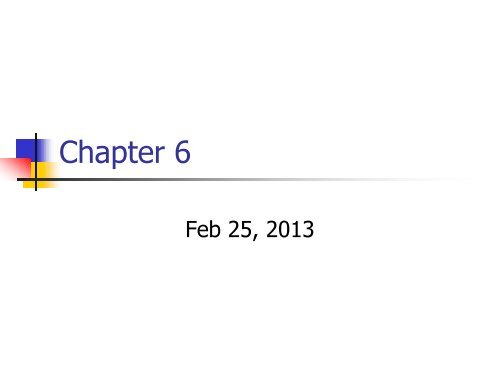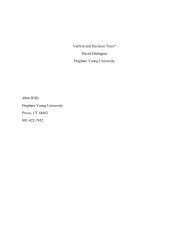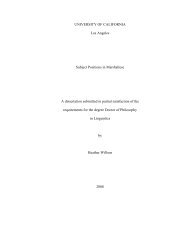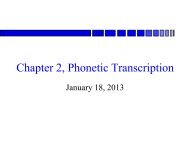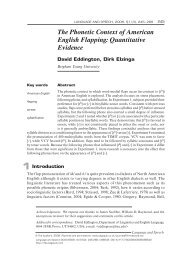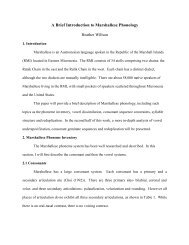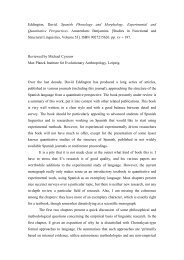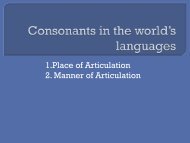Airstream Mechanisms and Phonation Types - Department of ...
Airstream Mechanisms and Phonation Types - Department of ...
Airstream Mechanisms and Phonation Types - Department of ...
Create successful ePaper yourself
Turn your PDF publications into a flip-book with our unique Google optimized e-Paper software.
Chapter 6<br />
Feb 25, 2013
Consonant Chart
1. Photography<br />
Taking photographs<br />
can help document<br />
the position <strong>of</strong> the<br />
lips, jaw <strong>and</strong> (to a<br />
certain extent) the<br />
tongue for various<br />
articulations<br />
Isoko<br />
From<br />
Ladefoged<br />
(2005)
2. Static palatography<br />
Can be used to determine exact place <strong>of</strong><br />
articulation <strong>of</strong> isolated sounds (palatograms <strong>and</strong><br />
linguagrams)<br />
Nunggubuyu – From Ladefoged, 2001
How can we tell the place <strong>of</strong><br />
articulation?<br />
1. palatogram—oil on palate--chalky<br />
substance on tongue—speaker makes<br />
a sound—then top <strong>of</strong> mouth is<br />
photographed.<br />
2. linguagram—oil on tongue then chalky<br />
substance is applied to palate—<br />
speaker makes a sound—then tongue<br />
is photographed
From Ladefoged, 2001<br />
A (static) palatogram A (static) linguagram
Dental vs. alveolar<br />
From Ladefoged,<br />
2001
Retr<strong>of</strong>lex vs. retracted alveolar<br />
From<br />
Ladefoged,<br />
2001
3. Electropalatography<br />
Can be used to<br />
examine specific<br />
articulations (like<br />
static<br />
palatography) but<br />
also coarticulation
Works to help children with down’s<br />
syndrome—they prefer visual learning
4. Electromagnetic Articulography<br />
EMA involves the use <strong>of</strong> silver<br />
pellets, stuck on the lips <strong>and</strong> tongue<br />
<strong>of</strong> the speaker<br />
The equipment tracks the movement<br />
<strong>of</strong> these pellets<br />
From the UCLA website
5. Ultrasound<br />
Front <strong>of</strong> tongue
6. Aerodynamic recordings<br />
Measurements <strong>of</strong> air pressure (at various points <strong>of</strong> the vocal tract)<br />
<strong>and</strong> nasal flow <strong>and</strong> oral flow masks can be used<br />
Determine the nasality <strong>of</strong> segments<br />
Detect differences between voiced <strong>and</strong> voiceless segments<br />
Investigate differences in phonation (e.g. breathy voice)<br />
From the UCLA website
7. EGG (Electroglottograph)<br />
Measures contact<br />
between the vocal<br />
folds
Consonant Chart
Four parts <strong>of</strong> producing a<br />
speech sound<br />
1. Initiation (airstream mechanisms)<br />
2. <strong>Phonation</strong><br />
3. Oro-Nasal process<br />
4. Articulation
Initiation or “<strong>Airstream</strong><br />
mechanism” involves<br />
1. Location <strong>of</strong> Closing <strong>of</strong> <strong>Airstream</strong><br />
(pulmonic, glottalic or velaric)<br />
2. Direction <strong>of</strong> airstream (ingressive or<br />
egressive)<br />
3. Trappings <strong>of</strong> air <strong>and</strong> release<br />
4. Vocal folds (voiceless, voiced, creaky,<br />
breathy)
Direction <strong>of</strong> airflow:<br />
a. Egressive
. Ingressive
<strong>Airstream</strong> <strong>Mechanisms</strong> (combination <strong>of</strong><br />
location <strong>of</strong> airstream <strong>and</strong> direction <strong>of</strong><br />
airflow)<br />
Definition: The flow <strong>of</strong> air as a sound is produced<br />
Pulmonic Egressive<br />
Pulmonic Ingressive<br />
Glottalic egressive<br />
Glottalic ingressive<br />
Velaric ingressive
So . . . For each airstream<br />
type . . .<br />
1. Describe where air originates from <strong>and</strong> where it is<br />
blocked in articulation<br />
2. Describe direction <strong>of</strong> the air<br />
3. Describe how the air is released
1. Pulmonic Egressive<br />
Steps <strong>of</strong> Pulmonic Egressive:<br />
1. Diaphram contracts<br />
2. Air flows into lungs<br />
3. Air is pushed out <strong>of</strong> the lungs by a<br />
downward movement <strong>of</strong> the rib cage or<br />
upward movement <strong>of</strong> diaphram (contraction<br />
<strong>of</strong> abdominal muscles)<br />
Example sounds: /p/, /s/, /f/<br />
(all sounds in English)
Pulmonic Eggressive<br />
Percentage <strong>of</strong> sounds in world’s<br />
languages that are pulmonic<br />
eggressive?<br />
88%<br />
All languages have pulmonic eggressive<br />
sounds
2. Pulmonic Ingressive<br />
Air is pushed into the lungs by an<br />
upward movement <strong>of</strong> the rib cage or<br />
downward movement <strong>of</strong> diaphram<br />
Sounds made when one is out <strong>of</strong> breath<br />
Which languages have these sounds?<br />
(no known sounds like this in languages)
Robert Eklund’s Ingressive<br />
Speech Page<br />
http://roberteklund.info/<br />
http://ingressivespeech.info/<br />
Places in the world where ingressive speech has been documented
Key to map<br />
lightest<br />
green<br />
mid<br />
green<br />
darker<br />
green<br />
darkest<br />
green<br />
star<br />
?<br />
Ingressive phonation mentioned, for e.g., pain or surprise.<br />
Paralinguistic sounds used, e.g., Japanese hiss.<br />
Single words are pronounced ingressively, e.g., Swedish “ja”,<br />
“jadå”.<br />
Entire phrases are produced ingressively, e.g., Argentine<br />
Spanish “un trabajo matador”.<br />
Star symbol used for areas too small to be filled in (e.g.,<br />
Malta, Vanuatu, Faroe Isl<strong>and</strong>s).<br />
Sources unclear/not explicit whether entire country/region is<br />
implied.
Other places<br />
Newfoundl<strong>and</strong>, Canadian Maritimes, Maine, Irel<strong>and</strong>,<br />
Scotl<strong>and</strong><br />
French<br />
Faroese, Icel<strong>and</strong>ic, Danish, Norwegian, Finnish,<br />
Swedish, Northern German<br />
Mongolian (yes, no, I don’t know)<br />
Ewe <strong>and</strong> Togolese<br />
Tagalog, Waray Waray, Borongan Oras, Artache,<br />
Dolores(all in Samar). (Oh)<br />
Japanese “hiss” (means no)
3. Glottalic egressive<br />
(ejectives)<br />
Steps for ejectives<br />
Air in lungs is trapped below glottis<br />
Air is also closed <strong>of</strong>f in vocal tract (bilabial,<br />
alveolar, velar, etc)<br />
Upward movement <strong>of</strong> the glottis forces air<br />
out <strong>of</strong> the mouth (egressive) Glottis acts<br />
like a piston<br />
Voiceless<br />
Ejectives are written p’, t’, k’
Ejectives<br />
1. Closure in oral cavity <strong>and</strong> closure <strong>of</strong><br />
glottis<br />
2. Glottis is raised (upward movement)<br />
3. Air in pharynx is compressed<br />
4. Closure in oral cavity is released.<br />
5. Glottal closure is released.
http://www.youtube.com/watch?v=D4W0Gm4iSqI 2.42<br />
To make ejectives . . .<br />
Practice raising <strong>and</strong> lowering the glottis by<br />
going back <strong>and</strong> forth from lowest to highest<br />
note you can sing on /a/<br />
Make a glottal stop—keep glottis closed<br />
Put the tongue in the position to make a /k/<br />
Raise larynx<br />
Release /k/<br />
Release glottis<br />
http://homepage.ntu.edu.tw/~karchung/Phonetics%20II%20page%20four.htm
Ejectives<br />
Languages with ejectives<br />
http://www.youtube.com/watch?v=LgoXJ8YlOEk<br />
http://www.youtube.com/watch?v=PS3OIc3GCy0<br />
Caucasian languages<br />
Salish Languages (Lushootseed)<br />
Afro-Asiatic languages<br />
Mayan languages
Glottalic Egressive (Ejectives)<br />
1. In how many languages do they occur?<br />
18 percent<br />
2. In what two language groups are they most<br />
common?<br />
Mayan <strong>and</strong> Caucasian<br />
3. What place <strong>of</strong> articulation is most common for these<br />
ejectives?<br />
Velar<br />
4. What kinds <strong>of</strong> consonants are they (fricatives, stops,<br />
nasals, or approximants?)<br />
Stops <strong>and</strong> fricatives<br />
5. Can ejectives be voiced <strong>and</strong> voiceless<br />
It is physically possible but no known voiced phonemes<br />
have been found
Lakota
Implosives<br />
1. Closure in oral cavity (closure 1)<br />
(like making a “b”)<br />
2. Downward movement <strong>of</strong> glottis<br />
3. Air from lungs comes through<br />
glottis still<br />
4. Change in air pressure in mouth<br />
5. Release <strong>of</strong> closure in oral cavity<br />
(release <strong>of</strong> “b”)
:18<br />
Implosives (glottalic<br />
ingressive)<br />
http://www.youtube.com/watch?v=OWSb<br />
RLqZdyY<br />
Languages with implosives:<br />
Sub-saharan African languages (Bantu<br />
languages, Xhosa, Zulu, etc)<br />
Mayan languages (usually limited to one<br />
place <strong>of</strong> articulation<br />
Southeast Asia (Vietnamese)
Implosives<br />
1. What percent <strong>of</strong> the world’s languages have<br />
implosives?<br />
About 10 percent<br />
2. Where do most <strong>of</strong> them occur?<br />
West Africa<br />
3. Are implosives voiced or voiceless?<br />
Voiced<br />
4. Which place <strong>of</strong> articulation is the most common?<br />
Bilabial<br />
5. Can languages have both ejectives <strong>and</strong> implosives?<br />
Yes, though very few do.
Sindhi
Clicks<br />
1. Closure in front <strong>of</strong> oral cavity<br />
2. Closure at velar area<br />
3. Tongue in between front closure <strong>and</strong> velar<br />
closure moves down<br />
4. Closure in front <strong>of</strong> oral cavity is released—<br />
air flows in<br />
5. Velar closure is released<br />
http://www.vowels<strong>and</strong>consonants3e.com/C<br />
hapter%2014%20video/Video%2014.13-Xray%20<strong>of</strong>%20a%20Click.MOV<br />
http://speech.umaryl<strong>and</strong>.edu/movies/clicks<br />
_Am<strong>and</strong>a_M_O/25.1.mov
Clicks<br />
1. ʘ bilabial<br />
2. | dental<br />
3. ǃ alveolar<br />
4. ǂ palato-alveolar<br />
5. ‖ lateral alveolar<br />
http://www.youtube.com/watch?v=c246fZ-7z1w
Languages with clicks<br />
http://www.youtube.com/watch?v=OAPY6W<br />
kNY1A (.45)<br />
Languages with clicks<br />
Bantu languages<br />
Khosian languages (Southern Africa)<br />
East African
Zulu<br />
http://www.yourdictionary.com/elr/ku!khaa<br />
si.wav
Parts <strong>of</strong> Speech Production<br />
1. Initiation<br />
2. <strong>Phonation</strong><br />
3. Articulation
State <strong>of</strong> the Glottis<br />
What is the “state <strong>of</strong> the glottis”?<br />
Refers to the<br />
1. Stiffness <strong>of</strong> the glottis<br />
2. Vibration along glottis<br />
3. Rate <strong>of</strong> airflow


